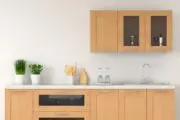While most new home buyers are focused on upgrades such as countertops and cupboards, golf simulators have become the sleeper hit of the new home circuit as more new owners look to add a new dimension to their new builds.
Internet searches for “basement golf simulator’ leapt more than 1,900 percent in the last year. The trend was also highlighted in Houzz.com’s recent Emerging Trends report, which showed a 20x uptick for golf simulators in its top emerging interior design trends category.
What’s driving the golf simulator interest? The uptick piggybacks on the rising trend for homeowners wanting to make the most of their basements.
“Many search terms relating to fun basement features like movie theaters, game rooms and home gyms, all reflect an increased interest in building these spaces out,” says Houzz senior editor Mitchell Parker.
In addition to being sought after by golfers of all ages and abilities, golf simulators are innately multi-purpose, as they can be set up for movies, video gaming or streaming fitness videos and classes, all on the big screen, when not in golf mode, so there is something for everyone in the household.
For homeowners wishing to hone their hobby in an all-season space, what is involved with installing a golf simulator? From choosing the right features to the right space in your home, here are some pro tips to make your at-home golf experience a winner.
How do golf simulators work?
Essentially, a golf simulator is constructed by assembling various parts that include a playing surface, impact screen, launch monitor (the heartbeat of the analytics), projector, laptop or tablet to run software and enclosure (usually curtains or netting).
Golf simulators can be assembled part-by-part for those inclined to DIY, but more commonly, companies sell complete, golf-simulator-in-a-box packages. Additionally, for those who are serious about their training, or looking to elevate their experience, custom options are available.
You can play a round of golf, solo or with a group; you can use the simulator as a driving range, or to perfect your short game.
Golf simulators deliver detailed analytics by assessing multiple data points (depending on your launch monitor) for everything from shot distance, height and speed to spin and more.
What should I know about installing a golf simulator?
Available space is the biggest consideration for a golf simulator.
“The biggest factor is the space,” says Aaron Hawke of Simply Golf Simulators. “There needs to be enough room to swing your golf club,” he says.
For comfort and safety, there needs to be ample height for swing clearance (which is generally a minimum of 9 feet, with 10 feet ideal for most people of average height).
Length and width of the space are as important, because these dimensions matter when it comes to accommodating the impact screen and picture resolution (a big part of an authentic golf experience) and play a functional role in the look and feel of the simulator space.
“You need proper width to hold the screen,” says Hawke, being mindful of the picture size, and that “you ideally want a rectangular shape versus a box shape,” he says. A bare minimum of 10 feet is required, but wider is advisable for on-screen resolution.
Too narrow a screen will affect your shot accuracy, advises James Laidlaw of InHome Golf. “If you want to hit center, you need room on the left and room on the right,” he says.
As for length, “If the room (where the simulator is located) is going to double as a family room or entertainment room, which is often the case, you need extra space,” says Laidlaw, with golf bags, chairs, tables and of course, golfers, taking up room.
It’s advisable to hit the ball 12 feet from the screen, says Laidlaw, to permit proper clearance in front and behind.
The ideal golf simulator area measures 10 feet high by 15 feet wide by 25 feet long. That’s not to say that a golf simulator can’t fit in a smaller space, but this context helps homeowners to frame expectations around the overall experience with their simulator.
In addition to space availability, the biggest factor to consider is budget, with standard, simulator-in-the-box models generally costing in the range of $3,000-$15,000, while custom-designed simulators are significantly more expensive, and can easily reach $50,000 to $150,000 or more.
Creating the right ceiling height
One of the greatest challenges putting in a golf simulator is achieving adequate ceiling height, especially considering that many homeowners are putting simulators in their basements, which are traditionally lower, compared to the rest of the home.
New build homeowners have an advantage in that they can create high ceilings on their lower level at the construction phase, avoiding the need to alter the space to accommodate a simulator down the road. Golf simulators aside, having higher basement ceilings is a recommended builder upgrade to add value and are a desirable design feature.
However, Laidlaw cautions new build homeowners to be aware of everything that eventually will be in a proposed golf simulator space, including ductwork and HVAC systems. While a room might look ideal at the early part of the construction phase, having structural items placed within the room will require a shift in specifications, which may mean a smaller, less feature-heavy golf simulator than the homeowner is expecting.
“Many times, we’ve gone into a new build into a wide-open room while the home is under construction, and then we come back and there is ductwork running through the ceiling. Make sure there’s nothing else going through this room, “says Laidlaw, as HVAC and other structural components that might traverse your golf zone are ultimately going to detract from your golf space.
Want to install a simulator in your existing home? Achieving ceiling height might require excavation, which happens commonly, according to Laidlaw, but homeowners should “have an engineer do a plan and get the proper permits,” he says, because of the potential for future water damage and other issues post-excavation, if not done properly.
Sometimes creating higher ceilings requires a creative solution, as opposed to structural changes, according to Hawke.
“A recent customer with 8-foot ceilings, took out the drop ceiling which gave him enough room,” for swing clearance, he says,
Beyond the basement, where are people putting golf simulators?
Although the basement is the most popular, golf simulators are appearing throughout the home in other areas.
Laidlaw estimates that around 35 percent of the simulators they install are not in the basement, many of which are located on the main floor, particularly in custom-designed homes, “often in a room off of the kitchen,” he says.
The garage is a common at-home golf destination, says Hawke, explaining that space in a garage is often readily conducive to a golf simulator, with higher ceilings.
“There are screens that can be used behind the garage door and roll up when not in use,” says Hawke, so homeowners can park their cars inside when the “course” is closed, although a portable screen may not be ideal with a custom simulator design.
If you are thinking about a simulator in a spare bedroom, Hawke cautions to be mindful of space around the simulator, so to “protect the walls properly, with side nets, curtains and extra padding,” he says.








